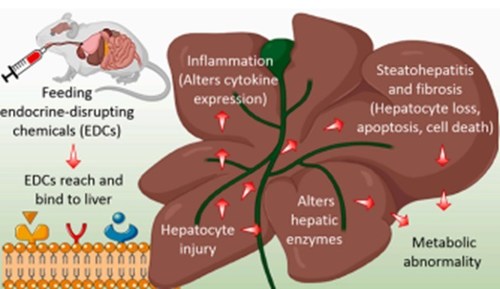SEOUL, South Korea, Aug. 5, 2022 /PRNewswire/ — We are increasingly being exposed to endocrine-disrupting chemicals (EDCs) that interfere with the normal functioning of our hormones. Bisphenol A (BPA) and phthalates, which are widely used in consumer products including plastics, aluminum cans, pharmaceuticals, and cosmetics, are well-known EDCs.
Since both BPA and phthalates are structurally similar to steroid hormones that regulate chemical signaling in the body, they are capable of manipulating and disrupting hormonal functions. The human liver converts these EDCs into non-toxic water-soluble metabolites for excretion via urine. However, this biotransformation process generates reactive intermediates that may cause cell death and organ failure.
Studies involving animal models and human urine samples have confirmed the positive correlation between exposure to individual EDCs and abnormal liver function. However, they fail to consider real-life scenarios where uncontrolled multi-chemical exposure occurs simultaneously.
To address this issue, Professor Myung-Geol Pang and his colleagues from Chung-Ang University, Korea investigated the effects of the combined exposure to BPA and phthalates on liver function and metabolic homeostasis in mice models. Elaborating on their study’s design, Prof. Pang observes, “We determined the combined effects of multiple EDCs using a real-life risk simulation concept.” Their study was made available online on May 26, 2022 and is to be published on August 15, 2022, in volume 436 of the Journal of Hazardous Materials.
Prof. Pang and his team evaluated the effects of BPA and an EDC mixture consisting of BPA and seven phthalate compounds on male mice. They observed that neither BPA alone nor the EDC mixture affected liver function at the permissible human daily exposure (DE) limits defined by the Ministry of Food and Drug Safety in Korea. However, significant changes were observed when the dose of the EDC mixture was increased to 25, 250, and 2500 times the DE limit. In addition to high blood glucose levels, there was a considerable accumulation of fat, triglyceride, and cholesterol in the liver. The scientists speculated that the EDCs induced the expression of key genes involved in glucose production and transport, which ultimately impacted liver health.
The team next examined the blood serum components that are indicative of liver injury. Increased levels of the enzyme aminotransferase were observed upon exposure to EDC mixture that was over 25 times the recommended DE level, indicating liver damage. Additionally, an aspartate and alanine aminotransferase ratio of >1 was observed, which indicated a higher risk of non-alcoholic fatty liver disease and liver fibrosis. Moreover, anti-inflammatory cytokines were found to be aggravated in EDC-exposed mice, which resulted in steatohepatitis, a condition where excessive fat accumulates in the liver. Notably, the mammalian immune system secretes pro-inflammatory cytokines in response to hazardous chemicals, such as EDCs, or infections, thereby contributing to liver inflammation.
Interestingly, markers of oxidative stress and apoptotic cell death were also abundantly present in the EDC-exposed mice. The scientists attributed this to the reduced antioxidant capacity of the liver damaged by the EDCs.
This study is important in that it evaluates the impact of toxic chemicals in real-life scenario, which is needed to underscore and define their permissible levels in consumer products. “Combined EDC exposure may increase overall EDC ingestion, resulting in significant health consequences,” explains Prof. Pang. What implications might their findings have? “Our study tried to change the conventional toxicological approach and we hope it has an enormous impact on regulatory and public health perspectives,” says Prof. Pang.
Reference
Title of original paper: Hepatic consequences of a mixture of endocrine-disrupting chemicals in male mice
Journal: Journal of Hazardous Materials
DOI: https://doi.org/10.1016/j.jhazmat.2022.129236
*Corresponding author’s email: mgpang@cau.ac.kr
Read more about Prof. Pang here: https://scholarworks.bwise.kr/cau/researcher-profile?ep=315
Website: https://neweng.cau.ac.kr/index.do
Seong-Kee Shin
02-820-6614
341986@email4pr.com
SOURCE Chung-Ang University

